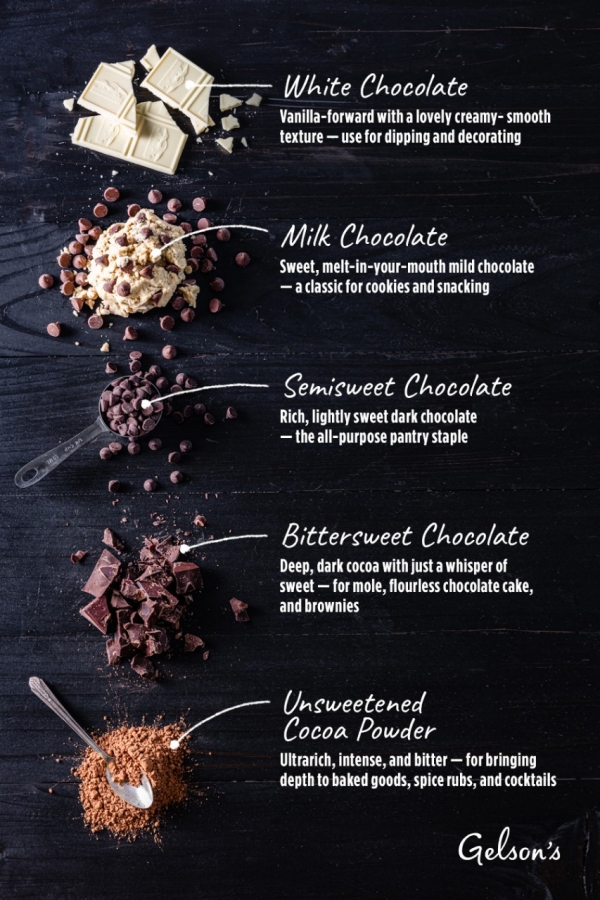Announcements
- Home /
- Announcements /
- A home cooks guide to chocolate
A Home Cook’s Guide to Chocolate

Ask just about anybody what sort of chocolate they prefer, and chances are they’ll have plenty to say about it. Most of us have (strong) feelings about the stuff: Maybe we like the cream-and-sugar sweetness of milk chocolate — and the way it melts in our mouths, silky and smooth. Maybe we go for the ultrarich dark chocolate — lightly sweet, delightfully bitter, and wine-like in its complexity. And what about white chocolate? Well, that’s a yes or no question. (We hear you out there, silently screaming your answer.)
But when it comes to baking and cooking with chocolate, all those great big opinions disappear — every chocolate has its place and application. For this guide, we asked our test kitchen chefs how they use chocolate, from white to dark and all the gradations in between. (Yes, even white chocolate can be useful in the kitchen.)
Before we dig into their thoughts, here’s the highly abbreviated CliffsNotes version of how chocolate is made: Basically, cocoa beans are removed from their pods, fermented, dried, and roasted. Their shells are tossed, and what remains is the cocoa nib, which gets ground up into a paste called chocolate liquor, a combo of cocoa solids and fatty cocoa butter. The cocoa solids become cocoa powder, the stuff that gives chocolate its color, flavor, beneficial nutrients, and caffeine; the fatty cocoa butter is extracted and added back in later — it provides the creamy mouthfeel.
When you see the cocoa percentage on a package of chocolate, it tells you the amount of cocoa solids in it. Legally, a chocolate must be at least 10% cocoa solids to be considered chocolate. The higher the cocoa solids, of course, the more rich, chocolaty flavor. The lower the cocoa solids, the more other stuff a chocolate has in it, like milk, sugar, and emulsifying fats — and that can be a great thing, depending on what you’re doing with it, as we’ll see here.
White Chocolate
As any true chocolate snob will tell you, white chocolate is technically not chocolate because there are no cocoa solids in it. What it does have is plenty of cocoa butter — around 32% for the good stuff. It’s also made with milk, sugar, vanilla, and other fats, so it has a lovely creamy-smooth texture and vanilla-forward flavor, though you’ll sometimes taste hints of citrus or nuts in it.
It’s sweet and unchallenging, which makes it great for combining with other flavors — we love ginger snaps, dried fruit, roasted nuts, or salty pretzels dipped in white chocolate. It’s sublime melted into buttercream frosting. And our pastry chefs use it for decorating: its clean white lines are extremely pretty drizzled over cakes and chocolate truffles, but you can also add color to it. Think: bright green matcha white chocolate.
Milk Chocolate
On average, milk chocolate is about 32% cocoa — the other 68% is a blend of milk, sugar, and fats. It’s beloved for its sweet, mild chocolate flavor and luxuriously melty mouthfeel.
Milk chocolate is the one we use when we’re making classic, straightforward chocolate chip cookies. It’s the one we fold into our buttermilk pancakes and banana nut muffins. And it’s the one we raid the pantry for, when it’s late in the day, and we crave a little nibble of chocolate with our coffee.
Semisweet Chocolate and Bittersweet Chocolate
If you’ve ever pondered the difference between semisweet and bittersweet chocolate (sometimes simply referred to as dark chocolate), you’re not alone. According to the chocolate laws, they are one and the same, and must contain less than 12% milk — and a minimum of 35% cocoa.
That said, semisweet chocolate generally falls in the range of 60% cocoa, and it is the sweeter of the two. If you’re only going to have one chocolate in the pantry this is it; you can use it everywhere, pretty much. If you love dark chocolate, its rich flavor might be more satisfying than milk chocolate in a sweet dessert where there’s already plenty of sugar, like our raspberry pots de creme, Hatch chile chocolate chip cookies, and chocolate macaroon cake.
Bittersweet chocolate will often have a higher amount of cocoa (around 70%), and therefore a richer, more bitter flavor. We like to use it in desserts where deep, dark sophisticated chocolate is the lead flavor, like brownies and flourless chocolate cake. We recently used it in a brown butter oatmeal cookie, where we wanted a less sugary profile so the nuts would shine. And bittersweet chocolate is also great for savory dishes, like mole, barbecue sauce, and crackers.
Unsweetened Cocoa Powder
Unsweetened cocoa powder is the purist of the pure — 100% cocoa. If you dip your finger in it, you’ll find it has a soft, chalky texture. We like to use it in baking because it has an ultrarich, concentrated flavor, and it gives us complete control over the sugar, and perhaps even more importantly, the fats. Cocoa powder yields a moister, lighter crumb than melting chocolates, which have emulsifiers and cocoa butter that tend to become dense and crumbly as they cool.
In particular, unsweetened cocoa powder is great in breads, brownies, and cakes. Because its flavor is so intense, we often use it in combination with a semisweet or bittersweet chocolate — as you’ll see in the recipes linked above. Of course, we always keep a little cocoa powder in the pantry for making hot cocoa, and we’ve even used it in mezcal cocktails. And, in its powdery form, it’s excellent for decorating (truffles!) and for making spicy chile rubs for pork or chicken.